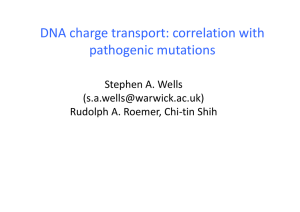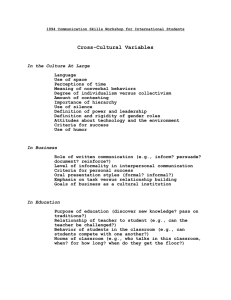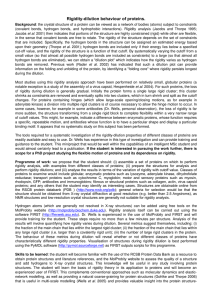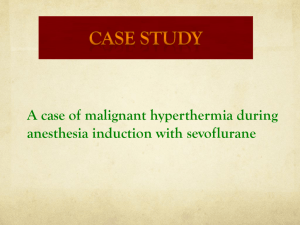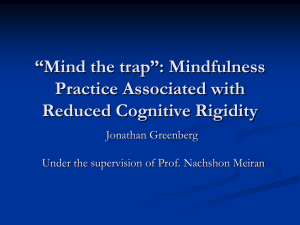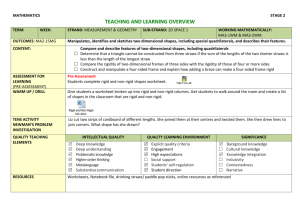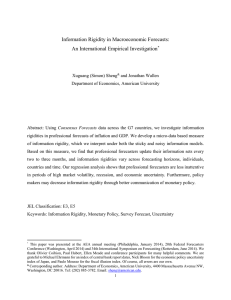Rapid simulation of protein functional motion Dr. Stephen A. Wells
advertisement
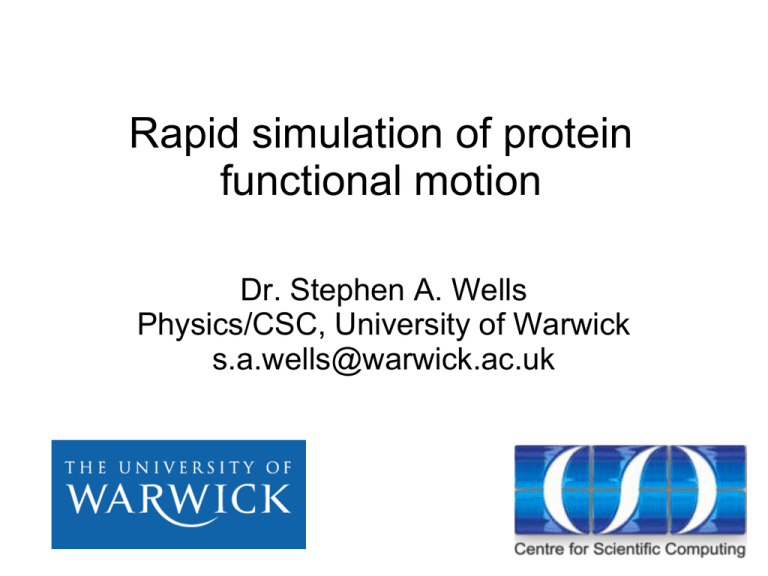
Rapid simulation of protein functional motion Dr. Stephen A. Wells Physics/CSC, University of Warwick s.a.wells@warwick.ac.uk Overview Protein Flexibility Computational tools Rigidity analysis Flexible motion Proteins are intrinsically flexible Proteins are intrinsically flexible Proteins are intrinsically flexible A protein structure is never unique. Each structure is a member of a flexible ensemble. How can we investigate, understand, predict flexible motion? Computational tools Molecular dynamics – empirical potentials • “Physical” • Individual trajectories •Ab-initio/electronic structure • ONETEP •Coarse-grained MD •Inference from structures • Elastic network model • Rigidity analysis: FIRST •Flexible motion • Geometric simulation: FRODA • Rigidity analysis We can treat a protein as a molecular framework. Atoms have degrees of freedom; bonds introduce constraints. “Pebble game” algorithm matches DOF to constraints to identify rigid and flexible regions. Software “FIRST” from Thorpe group at ASU (Flexible inclusions and rigid substructure topography). Main-chain rigidity On hydrogen bonds D.J. Jacobs, A.J. Rader, M.F. Thorpe, and L.A. Kuhn (2001) Protein Flexibility Predictions using Graph Theory. Proteins, 44, 150-165. Hydrogen-bond dilution plots B.M. Hespenheide, A.J. Rader, M.F. Thorpe and L.A. Kuhn (2002) Identifying Protein Folding Cores: Observing the Evolution of Rigid and Flexible Regions During Unfolding. J. Mol. Graph. & Model., 21, 195 207 Rigidity of HIV protease Crystal structure 3LZU at energy cutoffs of -1.970 kcal/mol (left) and of -1.985 kcal/mol (right), showing an abrupt rigidity transition. Effect of inhibitor deletion Deletion of the bound inhibitor (darunavir) makes the flap region around residue 50 flexible earlier in the rigidity dilution, but has little effect on the rigidity of the core and active site. Two classes of inhibitor “Phi” is a ratio of energy cutoffs, indicating how flexible the flaps are relative to the core. “Delta-Phi” measures the rigidifying effect of inhibitors on the flaps. Major antiviral drug molecules fall into two classes: flap rigidifiers vs. active-site inhibitors. From rigidity to flexibility Rigid clusters provide a basis to simulate flexible motion Motivations: Connect static (crystal) and dynamic (NMR) structures Explore large-scale motions Cheap and cheerful “FRODA” (Framework Rigidity Optimised Dynamic Algorithm) – included with FIRST Elastic network models suggest directions for flexible motion We use the “ElNeMo” elastic network model to calculate mode eigenvectors. Eigenvectors are used to bias motion in FRODA. FRODA investigates flexible motion while maintaining rigidity constraints. Internal kinesin motor domain (1RY6) Internal kinesin motor domain (1RY6) Dependence on rigidity? Dependence on energy cutoff Dependence on energy cutoff Dependence on energy cutoff Amplitude exploration: PDI Emilio Jimenez and Moitrayee Bhattacharyya will have much more to say... Persistence of modes? 1HRC Persistence of mode eigenvector Mode mixing After projection over an RMSD ~ 1 A, the original mode 11 has a small overlap with the current mode 11 but has large overlaps with several flexible modes including 10, 13. Modes for flexible motion Modes calculated from mass-and-spring model Harmonic oscillator: inertia-dominated Protein Reynolds number? VL Å / s Å 10 6 (4 to 10) 2 1 10 m s Viscosity dominates: solvent pushes the protein along easy directions? What is the point? To have scientific value our simulations must connect back to experiment! Understanding and interpretation of: NMR, crystal diffraction data, AFM, FRET, linkers, functional studies... References FIRST/FRODA: http://flexweb.asu.edu (Thorpe et al.) ; pathways.asu.edu ElNeMo: http://www.igs.cnrs-mrs.fr/elnemo/ (Tirion, Tama, Sanejouand et al.) SA Wells, S Menor, BM Hespenheide and MF Thorpe "Constrained geometric simulation of diffusive motion in proteins.“ Physical Biology 2, S127-S136 (2005). SA Wells, JE Jimenez and RA Roemer "Comparative analysis of rigidity across protein families.“ Physical Biology 6, 046005 (2009). JW Heal, SA Wells, JE Jimenez-Roldan, RB Freedman, RA Roemer "Rigidity analysis of HIV-1 protease.“ Proceedings of IOP Condensed Matter and Materials Physics "CMMP10". Journal of Physics: Conference Series 286 (2011). JE Jimenez-Roldan, SA Wells, RB Freedman, RA Roemer "Integration of FIRST, FRODA and NMM in a coarse grained method to study Protein Disulphide Isomerase conformational change.“ Proceedings of IOP Condensed Matter and Materials Physics "CMMP10". Journal of Physics: Conference Series 286 (2011). Acknowledgements Rudo Roemer, Robert Freedman Emilio Jimenez, Jack Heal Mike Thorpe & ASU group Leverhulme, for my funding Royal Society for our workshop Thank you for your attention
